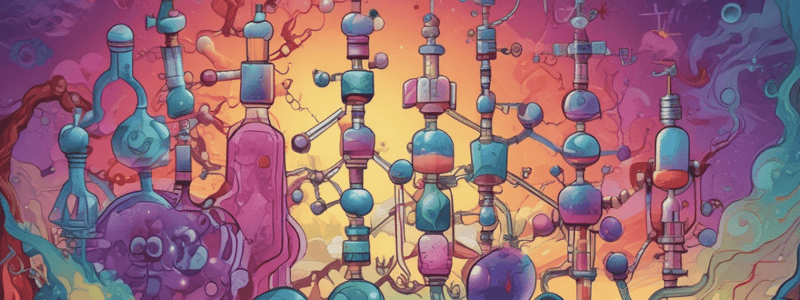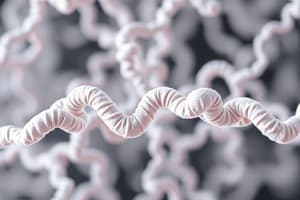Podcast
Questions and Answers
What is a possible reason for the preference of L amino acids in solution?
What is a possible reason for the preference of L amino acids in solution?
- L amino acids have a stronger covalent bond with each other
- L amino acids are slightly more soluble than a racemic mixture of D and L amino acids (correct)
- L amino acids have a stronger ionic bond with water
- L amino acids are less soluble than D amino acids
What is the common characteristic of amino acids classified as non-polar?
What is the common characteristic of amino acids classified as non-polar?
- They have no charge on the 'R' group (correct)
- They have a positive charge on the 'R' group
- They have a negative charge on the 'R' group
- They have a variable charge on the 'R' group
What is the importance of polarity in amino acids?
What is the importance of polarity in amino acids?
- It affects the solubility of the amino acid in water
- It determines the molecular weight of the amino acid
- It determines the protein structure (correct)
- It affects the pH of the solution
Which of the following amino acids is NOT classified as non-polar?
Which of the following amino acids is NOT classified as non-polar?
What is the basis for classifying amino acids into four groups?
What is the basis for classifying amino acids into four groups?
Flashcards are hidden until you start studying
Study Notes
Isoelectric Point (pI)
- The isoelectric point (pI) is the pH at which an amino acid has no net charge, and the concentration of positive and negative charge species is equal.
- For the simplest amino acid, glycine, pKa1 = 2.34, pKa2 = 9.6, and pI = 5.97.
Amino Acids with Acidic Side Chains
- The pI will be at a lower pH because the acidic side chain introduces an "extra" negative charge.
- The neutral form exists under more acidic conditions when the extra -ve has been neutralized.
- For example, aspartic acid has a pI = 2.77, which is halfway between pKa1 and pKa3.
Amino Acids with Basic Side Chains
- The pI will be at a higher pH because the basic side chain introduces an "extra" positive charge.
- The neutral form exists under more basic conditions when the extra +ve has been neutralized.
- For example, histidine has a pI = 7.59, which is halfway between pKa2 and pKa3.
Electrophoresis
- Electrophoresis is a technique used to show the distribution of charged species in a sample by observing the movement of solute molecules in an electric field.
- An ionic buffer solution is incorporated in a solid matrix layer, composed of paper or a crosslinked gelatin-like substance.
Titration Curve
- The titration curve for alanine demonstrates the relationship between pH and charge state.
- At a pH lower than 2, the alanine molecule has a net positive charge.
- At a pH greater than 10, the alanine molecule has a net negative charge.
- At intermediate pH's, the zwitterion concentration increases, and at a characteristic pH, called the isoelectric point (pI), the negatively and positively charged molecular species are present in equal concentrations.
Calculating pI
- The pI is given by the average of the pKas that involve the zwitterion, i.e., that give the boundaries to its existence.
- For neutral side chains, pI = 1/2 (pKa1 + pKa2).
- For acidic side chains, pI = 1/2 (pKa1 + pKa3).
- For basic side chains, pI = 1/2 (pKa2 + pKa3).
Classification of Amino Acids
- Amino acids are classified into 4 groups based on the general chemical characteristics of their R groups.
- The four groups are: non-polar, polar with no charge, polar with a positive charge, and polar with a negative charge.
- Non-polar amino acids are hydrophobic (water hating) and have no charge on the 'R' group.
- Examples of non-polar amino acids include alanine, leucine, isoleucine, valine, methionine, phenylalanine, tryptophan, and proline.
Studying That Suits You
Use AI to generate personalized quizzes and flashcards to suit your learning preferences.




